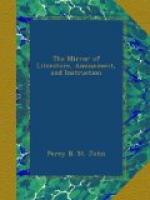The tone and temper of these two works—to us the first fruits of “the Annuals” are excellent, as their literary execution is admirable. The first has innumerable attractions for the young; its pleasantness consists in simplicity and truth, whilst its narratives of the playful incidents of childhood are interspersed with “good seed,” and precept and pretty illustration spring up in every page. The second work, the Amulet, is calculated for maturer age, and its literary pretensions are consequently of a more advanced order: but of these we shall speak more at length on a future occasion. Our intention in coupling the works at the head of this slight notice is to express our high esteem of the taste which has dictated the scholar and the gentleman in the production of the Amulet, and his ingenious lady in the “delightful task” of writing and catering for those of tender growth, in the Juvenile Forget-me-not. The association is indeed delightful, and has all the interest of a family picture: it beams with affection and parental love, truth, and nature; and happy, thrice happy, must be the union that is crowned with so amiable an intercommunity of mind.
The first few pages of the Juvenile Forget-me-not are very appropriately occupied by a playful paper by the late Mrs. Barbauld, the sincerity and tenderness of whose Lessons and Hymns we have never forgotten even amidst all the cares and crosses of after life. How often and how fondly too have we lingered over their delightful pages; and it may be questioned whether any works ever produced a better or more lasting impression on the infantine mind—than these unassuming little volumes. Mrs. Barbauld’s present article is entitled “the Misses, addressed to a careless girl”—as the Misses Chief, Management, Lay, Place, Understanding, Representation, Trust, Rule, Hap, Chance, Take, and Miss Fortune; the “latter, though she has it not in her power to be an agreeable acquaintance, has sometimes proved a valuable friend. The wisest philosophers have not scrupled to acknowledge themselves the better for her company, &c.” Then follow some pleasing lines to “My Son, My Son,” by Allan Cunningham, glorifying the bounty of Providence, “A Tale of a Triangle,” by Mary Howitt, is a pretty school sketch. Next are some lines by James Montgomery, on Birds—as the Swallow, Skylark, &c. in all, numbering forty-five. “The Muscle,” by Dr. Walsh, consists of half-a-dozen conversational pages, illustrating its natural history in a very pleasing style, which is really worth the attention of many who attempt to simplify science. Next Miss Mitford has a true story of “Two Dolls,” and the author of Selwyn a pretty little story, entitled “Prison Roses;” Miss Jewsbury, “Aunt Kate and the Review;” and Mr. S.C. Hall a sketch of a “Blind Sailor”—both of which are very pleasing. “A Child’s Prayer,” by the Ettrick Shepherd, is a sweet and simple hymn of praise. “The Royal Sufferer,” by Mrs. Hofland, follows, and gives the misfortunes of Prince Arthur in an interesting historiette.—We have only room to enumerate “The Birth-day,” a sketch from Nature, by Mrs. Opie; an extremely well-drawn Irish sketch, by Mrs. S.C. Hall; and “The Shipwrecked Boy,” a tale, by the author of Letters from the East.




